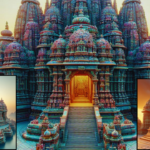Sabarimala Temple
In 1999, a tragic incident during the Makara Jyothi celebration on Sabarimala Hill raised questions about the authenticity of the divine phenomenon. Debates ensued, leading to court involvement, and later, in 2011, another tragedy prompted a deeper investigation. Science students argued it was human-made, while devotees insisted it was Ayyappa Swami’s manifestation. In this blog, we’ll explore the truths and rumors surrounding Makara Jyothi and uncover its science.
Makara Vilakku and Makara Jyothi:
Makara Vilakku, an annual lamp lighting, traces its origins to Ayyappa Swami’s request for a celebration on Sankranti. Over time, tribal rituals evolved into a massive lamp lighting. However, Makara Jyothi is different. It originated centuries ago when Ayyanar Ayyappa merged into Sabarimala Manikanta Ayyappa in the form of light on Makara Sankranti. This incident led to the worship of Ayyappa Swami in the form of Makara Jyothi.
Scientific Explanation:
Contrary to popular belief, Makara Jyothi has a scientific explanation. In the early 1980s, an astronomical phenomenon known as the Poynting-Robertson effect caused a light to appear on Sabarimala Hill. Soviet scientists corroborated this phenomenon. However, some individuals exploited it by constructing a platform on Ponnambalamedu, where a lamp could create the appearance of Makara Jyothi. This revelation, captured by journalist Radhakrishnan Kuttoor, exposed the truth behind the divine spectacle.
Astronomy and Spirituality:
Makara Jyothi, although scientifically explained, holds spiritual significance. Similar to how Arunachalam Hill appears as an Agni Lingam to advanced spiritual practitioners, Makara Jyothi can only be perceived by dedicated devotees and yogis. Makara Vilakku, lit annually, represents Makara Jyothi for those who cannot perceive it directly. It encourages devotees to focus on Ayyappa Swami’s form and teachings rather than being swayed by external phenomena.
Sabarimala in which District
Makaravilakku, a significant festival at the Sabarimala Temple in Kerala, holds profound importance for devotees of Lord Ayyappa. This annual celebration draws thousands of pilgrims who eagerly await the appearance of Makaravilakku, a divine light or flame, on the Ponnambalamedu hill, located 4 km away from the temple. Let’s delve into the significance and mystique of Makaravilakku in the upcoming year, 2024.
The Spiritual Gathering:
Makaravilakku is a magnet for devotees, with its spiritual significance attracting pilgrims from far and wide. The festival marks the culmination of the Mandalam season, a period of intense penance and devotion observed by Ayyappa devotees. The sight of thousands of devotees converging at the Sabarimala Temple creates an atmosphere charged with devotion and reverence.
The Divine Light:
The highlight of Makaravilakku is the appearance of a divine light or flame on the Ponnambalamedu hill. This phenomenon occurs three times, captivating the hearts of onlookers. The hill, situated 4 km from the temple, becomes a focal point as pilgrims await the symbolic illumination that is believed to carry spiritual significance.
Spiritual Significance:
Makaravilakku is not just a visual spectacle; it is a symbol of divine blessings and spiritual awakening. The appearance of the light is considered a divine presence, and devotees believe it symbolizes Lord Ayyappa’s blessings and protection. Pilgrims participate in rituals and prayers, seeking the grace of Lord Ayyappa during this auspicious occasion.
Tradition and Rituals:
The festival is steeped in tradition and rituals. Devotees undertake the arduous journey to Sabarimala, observing strict vows and penances along the way. The pilgrimage represents a spiritual journey, and the culmination at Makaravilakku is a moment of spiritual fulfillment for many devotees.
Cultural Celebration: Makaravilakku is not just a religious event but also a cultural celebration. The festival brings together people from diverse backgrounds, fostering a sense of unity and community among devotees. The cultural richness and diversity observed during the festival contribute to the vibrant atmosphere surrounding Sabarimala.
Preparations for Makaravilakku 2024: As the year 2024 approaches, preparations for Makaravilakku are underway. The temple authorities, along with the local community, are gearing up to ensure a smooth and spiritually enriching experience for the pilgrims. Enhanced security measures, logistical arrangements, and spiritual programs are part of the meticulous planning for this grand celebration.
Conclusion:
While the scientific explanation demystifies Makara Jyothi, it’s essential to recognize its spiritual symbolism. Devotees are urged to shift their focus from the external fascination with Makara Vilakku to the internal contemplation of Ayyappa Swami’s divine presence. In doing so, the true essence of Makara Jyothi – a symbol of spiritual enlightenment – can be experienced. Swamiye Saranam Ayyappa!
Makar Sankranti Date and Time
Makar Sankranti falls on January 15. This year, the festival will be celebrated on January 15. According to Drik Panchang, the Punya Kala will start at 7:15 AM and will end at 5:46 PM. The Maha Punya Kala will start at 7:15 AM and will end at 9 AM on January 15.
People also ask: Questions and Answers
1 why women’s are not allowed in Sabarimala
Women of menstruating age were traditionally restricted from entering Sabarimala Temple in Kerala due to the belief that the deity, Lord Ayyappa, is celibate. In 2018, the Supreme Court lifted the ban, citing discrimination. The issue reflects the tension between religious traditions and principles of gender equality and individual rights. The debate continues, shaped by legal decisions and evolving societal attitudes.
2. Why is Sabarimala famous?
Sabarimala is famous for its Ayyappa Temple, dedicated to Lord Ayyappa, a revered deity known for his celibacy. The temple is a significant pilgrimage site attracting millions of devotees annually, especially during the Mandala season. The pilgrimage involves strict vows, rituals, and a challenging trek, contributing to the fame of Sabarimala as a spiritually significant and culturally rich destination.
3. Why 41 days of fasting for Sabarimala?
The 41-day fasting period, known as “Vratham,” is observed by Sabarimala pilgrims as a form of purification and penance, mirroring Lord Ayyappa’s legendary 41-day forest penance before defeating the demoness Mahishi. Devotees follow strict rules during this time to cleanse the mind and body, preparing for their pilgrimage to Sabarimala and seeking the blessings of Lord Ayyappa.






